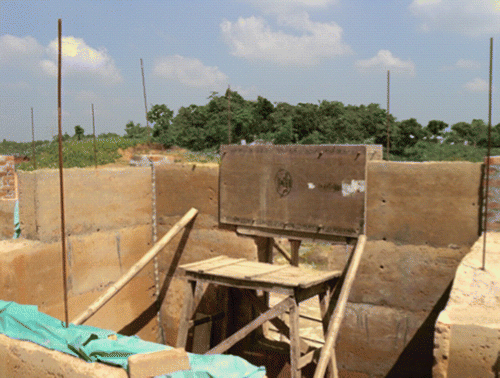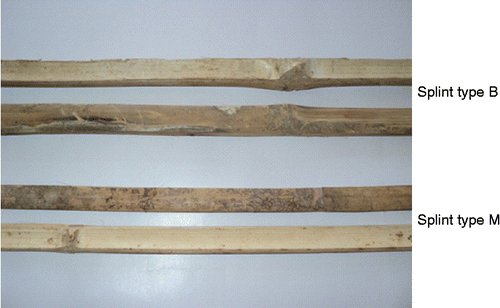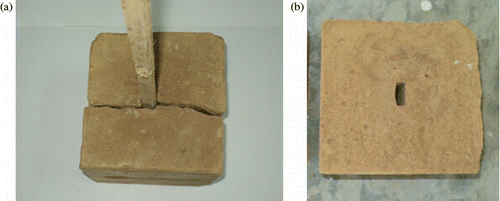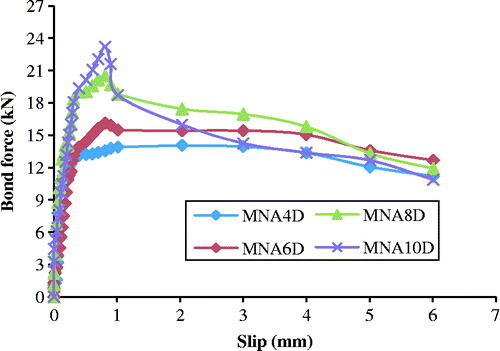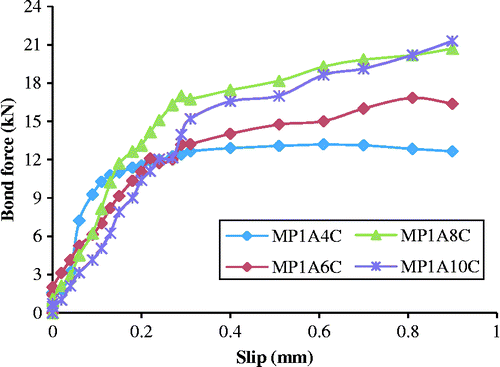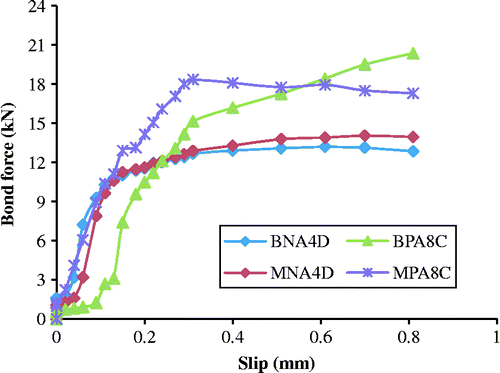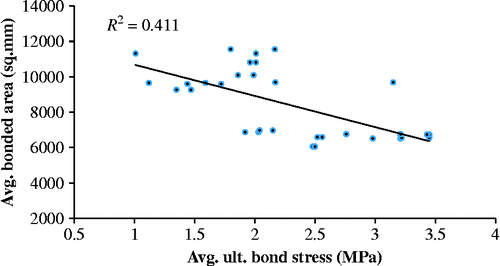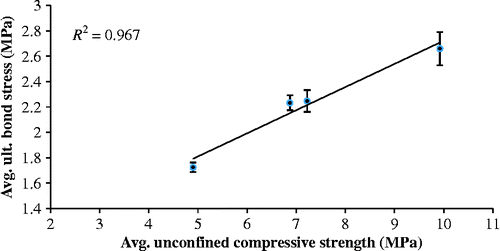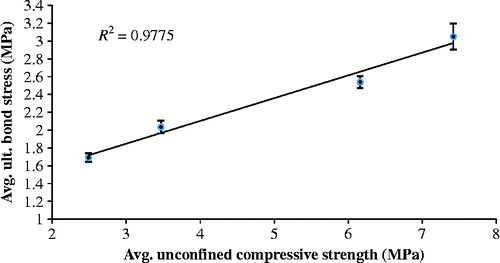Abstract
This paper represents an effort to study the bond characteristics of plain and noded bamboo splints embedded in cement-stabilised rammed earth (CSRE) blocks. A series of CSRE pullout test specimens and two species of bamboo, namely Melocanna Baccifera and Bambusa Balcooa having an average tensile strength of 384 and 310 MPa, respectively, were fabricated using 4–10% Portland cement. These bamboo species are commonly available and widely used for construction in the north-eastern part of India. Besides considering the effects of soil strength, cement content, splint size and type on bond force and slip, the effect of embedded area was also briefly considered as part of the test programme. The test result showed that pullout bond resistance is correlated to rammed earth compressive strength, splint size and type, and embedded area.
1. Introduction
Rammed earth is an ancient form of monolithic earth wall construction (Dethier Citation1982; Pearson Citation1992; Houben and Guillaud Citation1994). The Great Wall of China, the construction of which began about 3000 years ago, has extensive sections built on rammed earth and the Horyuji Temple in Japan has rammed earth walls built about 1300 years ago are some of the examples which are still performing well (Berge Citation2009; Hall and Djerbib Citation2004).
In general, rammed earth is an unreinforced material, except where it is necessary to provide additional seismic resistance, support over openings and uplift anchorage for roof structures. The thickness of the walls varies from 300 to 600 mm which are pneumatically or hand compacted in layers, between temporary sheets of vertical formwork, to its maximum dry density. Figure shows the cement-stabilised rammed earth (CSRE) wall construction at Agartala in the north-eastern part of India. Rammed earth has favourable insulation properties, with a high thermal mass necessary for passive solar architecture. In addition, rammed earth offers improved strength and durability and reduced materials handling compared to direct-shaped earthen building (Houben and Guillaud Citation1994).
Furthermore, to obtain greater strength and durability, very often the soil is stabilised with 4–10% Portland cement. The dry density of rammed earth is normally between 1700 and 2200 kg/m3, compressive strength is 2–15 MPa, thermal conductivity values are between 0.25 and 1.2 W/mk (Houben and Guillaud Citation1994) and the recommended design values for characteristic unconfined compressive strength are 0.4–0.6 MPa (SA Citation2002), 0.5 MPa (NZS 4298–Citation1998) and 0.7 MPa (Middleton and Schneider Citation1992). It is noted that although this value is relatively low when compared to bricks or concrete, the typical downward thrust of a single storey house is of the order 0.1 MPa (Houben and Guillaud Citation1994). Single storey load-bearing walls are typically 300 mm thick, with a maximum height-to-thickness ratio of < 8–20, depending on edge restraint conditions and area seismicity (Keable Citation1996; King Citation1996).
As rammed earth is an unreinforced structure, bamboo splints may thus be cast within the walls above and adjacent to door and window openings to provide additional seismic resistance. Gao et al. (Citation2009) studied experimentally the behaviour of rammed earth wall with bamboo cane under monotonic horizontal load. They found that the reinforcement improves the yield load, that the vertical bamboo ribs improve the ductility of the rammed earth and that vertically embedded rebars and threaded bolts are widely used to provide uplift anchorage for roof structures (Middleton and Schneider Citation1992). Ghavami (Citation2005) extensively studied the performance of bamboo as reinforcement in structural concrete elements. The bamboo-reinforced beam after testing has been exposed to open air in the PUC Rio university campus in Brazil, and it was observed that the bamboo segment of the beam reinforcement, treated against insects as well as for bonding with concrete, is still in satisfactory condition after 15 years. But the steel reinforcing bars of the concrete column after 10 service years were severely corroded and needed to be replaced. However, compared to the original untreated bamboo, a slight deterioration of tensile strength was observed in the weathered specimens of bamboo reinforcement. And it was also reported that the product called Sikadur 32-Gel, Negrolin plus sand and Negrolin plus sand plus wire, which was applied on the surface of reinforcing bamboo segment in the concrete, has increased the bonding strength by 5.29, 1.40 and 1.87 times, respectively, compared to the untreated segment of the bamboo.
In spite of well-documented limitations, pullout testing remains a popular means for measuring rebar bond in concrete (Jiang, Shah, and Andonian Citation1984; Popov Citation1984; Yankelevsky Citation1985; Cairns and Abdullah Citation1995; Abrishami and Mitchell Citation1996), and an attempt was made to study the bond behaviour of bamboo splints in rammed earth blocks. Prior to this study, no published literatures were available for the bond behaviour of bamboo splints embedded in rammed earth blocks.
2. Objectives
The primary objective of the work presented in this paper was to study and compare the characteristics of bamboo splints embedded in rammed earth blocks. Splints of Melocanna Baccifera and Bambusa Balcooa have been used, which are commonly available and widely used in the north-eastern part of India for building traditional houses. Influence of rammed earth properties on bond and slip was studied. Experimental results for bond and slip characteristics are presented in detail, and experimental results for the design and tensile anchorages in rammed earth and further works are also discussed in detail.
3. Experimental programmes
3.1 Rammed earth blocks
The soil specimen used in this study was collected from the depth between 0.5 and 1.5 m. The particle size distribution of the soil was determined in accordance with CitationIndian Standard, IS: 2720 (Part 4) – 1995. Wet sieve analysis was used to classify the granular materials and sedimentation for the cohesive material that is broadly suited to rammed earth construction (Houben and Guillaud Citation1994). Table outlines the properties of the soil specimen. Furthermore, OPC 43 grade was added to the soil, and a total of four different rammed earth mixes were produced for the test programme. Pullout test specimens were produced using the same type of soil designated ‘A’ blended with 4%, 6%, 8% and 10% Portland cement by dry mass of soil, respectively.
Table 1 Properties of the soil used.
The water content at which a specified compactive force can compact a soil mass to its maximum dry unit weight is known as optimum moisture content (OMC). To determine the OMC and maximum dry density, the soil specimen was first oven-dried to constant mass at a temperature of 105–110°C for 24 h and pulverised into a coarse powder manually, and then a standard Proctor test was carried out. The remaining soil specimen was dried in the sun, and OMC was determined by rapid moisture meter prior to application, thus ensuring additional level of standardisation. The soil was then thoroughly mixed in batches of 14 kg (dry mass) manually such that it is sufficient to produce two 150 mm cube specimens.
The moistened soil was compacted in three separate layers manually using a modified Proctor rammer; the layers were compacted perpendicular to the axis of each bamboo splint. It was discovered that the soil between 1950 and 2450 g amounted to approximately one-third the height of the cube mould when compacted. All the specimens were cast in the mild steel mould, and were removed within 30 min of casting. For determining the compressive strength, 12 cubes (150 mm × 150 mm × 150 mm) from each mix were cast by modified Proctor rammer in three layers. Details of 192 pullout test specimens (6 for each of the 32 different series) are given in Table . Half of the pullout and compressive strength test specimens were moist cured (C) under gunny bags, and the rest were dried (D) at an ambient temperature of 27–35°C and a relative humidity of 70–80% for 28 days. The plasticity index of stabilised soil specimens varies from 15.96% to 30.29%, with 10% cement stabilised soil being the minimum. The unconfined compressive strength test was carried out as per IS: 4332 (Part 5) – Citation2006. And the bamboo and rammed earth specimen of the failed pullout specimen from the region of the bonding interface was immediately transferred to a beaker, and its moisture content was assessed by drying at 110°C in an oven for 24 h.
Table 2 Details of pullout specimens.
A correction factor of 0.7 was applied to the compressive strength values of all the test specimens to account for platen restraint effects. Unconfined compressive strengths and dry densities of each mix, both cured and uncured, are given in Table .
3.2 Reinforcing bamboo splints
Five bamboos each of Melocanna Baccifera (M) and Bambusa Balcooa (B) were taken for the test programme. The specimens were harvested at an age greater than 3 years, and were then seasoned by air drying for 8 weeks in a standing upright position in the laboratory at ambient temperature. This method of seasoning fully resembles the onsite condition, and it is widely practiced in many parts of India. And then the test was conducted as per IS: 1708 (Parts 1, 9 & 12) – Citation2000. Table outlines the details of the test specimens.
Table 3 Test results of bamboo.
3.3 Test procedure
The bamboo splints were pulled from an embedment length of 150 mm from a 150 mm cube. The embedment length was same for all test specimens. Prior to casting, the surfaces of all splints were cleaned but not treated, as shown in Figure .
Each test specimen was placed into the supporting framework vertically in a Universal Testing Machine of 600 KN capacity having data acquisition system with the cube bearing against a 15 mm thick two steel plates supported against the moving platen of the machine. The bamboo splint passing through the passage was anchored in the opposing fixed end grip, and was then pulled out of the soil cube taking into account that no second effect occurs on the results due to gripping. As the bond force was applied, the free end slippage was measured using a 0.01 mm resolution dial gauge attached to the exposed splint as shown in Figure . The test was carried out as per IS: 2770 (Part 1)-Citation1997. All the pullout and compressive strength specimens dried at ambient temperature were tested in the laboratory, and similarly, the moist-cured specimens were tested after drying in an ambient temperature for 7 days. Besides considering the effects of soil strength, cement content and splint size and type on bond force and slip, the effect of embedment area was also briefly considered as part of the test programme. In no case, the tensile rupture load of the splints was attained during the test, thus measured displacement was resulted from the slip of the splint with respect to surrounding soil cube.
The bond stress τb was calculated by:
4. Experimental results and discussion
Experimental results for pullout bond testing are outlined in Table .
Table 4 Result of pullout test.
4.1 Mode of failure
In the pullout tests, the rammed earth pullout specimens with both the bamboo type failed either by lateral splitting or less commonly, due to pullout of the splint as shown in Figure . In no cases, did the splint fail due to tensile rupturing prior to bond failure. Lateral splitting failure of the specimens was expected and attributed to lateral tensile stresses caused by the deformations bearing onto surrounding rammed earth with higher cement content. This mode of failure is commonly observed in reinforced concrete specimens (Cairns and Abdullah Citation1995). The lateral splitting occurs almost parallel to the longer edges of the splints which can be attributed due to stress concentration at these edges, and the change in the embedment area by increasing splint perimeter did not alter this mode of failure. Pullout failure occurred once the shear strength of the bond between the splint and rammed earth was overcome. Ultimate bond force in noded specimens was dictated by the shear strength of rammed earth surrounding the splint. The failure pattern for both cured and uncured specimens resembles the same. The noded specimens split rapidly as soon as the node breaks off or the friction is overcome. The reason may be due to the localisation of stress in the noded region and due to uneven distribution of bond forces. And it can be further attributed that the bearing pressure between the node and CSRE blocks is almost inclined to the splint axis, which introduces radial forces causing circumferential tensile stresses in the CSRE blocks surrounding the splints and tending to split the blocks along the weakest plane. Furthermore, the rough nodes were observed to possess higher bond forces.
4.2 Bond force-slip relations
Typical bond force-slip relations for the experimental specimens are shown in Figures . Pullout failure is illustrated by an initial steep increase in bond force with slippage, followed by decay once the ultimate bond force is exceeded, as shown in Figure . It can be further observed that the bond force of MNA10D and MNA8D is higher than that of MNA4D specimens by about 46% and 38%, respectively, within the slip range of 1 mm. But there exist very little variation in bond force between MNA6D and MNA4D specimens. Bond can be attributed to bearing (noded splints only), adhesion and friction between the splints and rammed earth up to failure. Breaking of adhesive bond reduces friction at failure as the splint is pulled out further and the contact surface is worn. Bond force–slip relationships for those specimens failing by splitting are characterised by a steep but steady increase in bond levels up to failure, where the specimen fracture occurs and gradually decays the bond. Adhesion and friction are the important bond strength components for plain splint, and localised cracking was observed at the rough noded region and on the surface of the rammed earth cubes. Figure shows that there occurs a steep increase in bond force up to ultimate load and then gradually decrease due to friction around the embedded surface of plain splints. It was observed that the bond force of BPA10C and MPA8D is higher than that of MPA4D and BPA4C specimens by about 30–50%, within the slip range of 1 mm. However, the bond forces of cured specimens are slightly higher than those of uncured specimens.
The effect of compressive strength of rammed earth on the bond properties can be examined from the test results. It can be seen from Figure that the slope of the bond stress–slip curve for less compressive strength is lesser than that for higher strength. Approximately, the average ultimate bond strength for 10% CSRE blocks is 1.5 times and 1.8 times higher than that for 4% CSRE blocks for cured and uncured conditions, respectively. Thus, increasing the compressive strength of rammed earth can improve the bond properties. In other words, higher adhesion and frictional force between rammed earth and splint can be expected for rammed earth with higher compressive strength. The figure also clearly depicts that slippage due to compressive strength is non-uniform. It can be further observed that the average variation coefficient of bond stress increases with the increasing compressive strength of CSRE blocks accompanied by increasing bond stresses from 3.5% to 15% in both cured and uncured conditions irrespective of any type of splints, as shown in Table .
The initial ‘slip modulus’ (rate of change in bond force with slip) for noded splint embedded in CSRE blocks increases from 63 kN/mm (MNA4D) to 268 kN/mm (MNA10D) and from 20 kN/mm (BPA4C) to 122.5 kN/mm (BPA10C). However, although slip modulus is influenced, the total slip corresponding to failure is changed little by increasing the material strength as shown in Table . The average failure slip values did not exceed 2 mm in the test, but the corresponding values in reinforced concrete tests may exceed 10 mm due to different confinement conditions (Mo and Chan Citation1996).
Splint type has a significant influence on strength, failure mode and the bond force–slip relationship, which is shown in Figure . Both plain and noded splint specimens failed due to pullout as well as cube splitting. Bond force–slip relationship was little altered for splint with nodes and without nodes. The node type of different species of splint influences the bond stress with respect to their embedded surface area. The bond force of MNA4D is slightly higher than that of BNA4D; similarly for plain splints, BPA8C is higher than MPA8C, but the slight increase in ultimate bond force recorded for rough node is not considered significant. It can be further observed from the figure that the bond stress has a non-uniform distribution throughout the embedded length. It is well established that the distribution of bond stress along a length of splint during pullout testing is non-uniform; consequently, average bond stress at failure increases as embedment length decreases (Walker and Dobson Citation2001).
4.3 Ultimate bond strength
The tensile rupture load of the splints was not attained during any test. The ultimate bond stress of noded specimens of Melocanna Baccifera and Bambusa Balcooa varied between 17% and 31% and between 12% and 28%, respectively, of the specified rupture stress. Similarly, for plain specimens, the values varied between 9% and 18% and between 10% and 19.5%, respectively.
Figure shows that there exist a poor linear correlation between average ultimate bond stress and average bonded area corresponding to each type of compressive strength, given in Table . In both cases, either cured or uncured specimens, there exist a strong linear correlation between average ultimate bond stress and average unconfined compressive strength of rammed earth with constant bond length and varying bond area, as shown in Figures and . Mode of failure, either splitting or pullout, would seem to have had little impact on these relationships. Bond stress is least affected when tested on cured or uncured rammed earth specimens. This can primarily be attributed to a bearing, adhesion and frictional component of bond found within the embedment length and its surrounding surface. Furthermore, it can be observed from Figures and that the uncured specimen with 8–10% cement content has higher bond strength than the cured specimens by about 13–15%. This can be attributed due to higher moisture content up to 7–9% of bamboo splints and rammed earth blocks at the bonding interface of the cured specimens during testing. On the other hand, there exist hardly any differences in the bond strength of specimens with 4–6% cement content irrespective of cured and uncured specimens due to lower moisture content up to 3–5% of bamboo splints and rammed earth blocks at the bonding interface during testing. The bond strength between 12 mm diameter plain steel bar and CSRE block of 10.4 MPa compressive strength is about 0.81 MPa (Walker and Dobson Citation2001), and the value for untreated bamboo with 20–40 MPa compressive strength of concrete is about 0.52 MPa (Ghavami Citation2005). But higher values of 3.45 and 1.80 MPa, respectively, are obtained for MPA10D and BPA10C in this study.
5. Discussion
Cement stabilisation improves compressive strength and durability of rammed earth structures. This study has considered bond anchorage of different bamboo splints embedded in a range of CSRE mixes.
It is not possible to derive a series of generalised design values for anchorage bond strength from this pullout test programme, but the performance of tensile splints embedded in rammed earth under conditions similar to those of a holding down bolt is compared. The minimum (unconfined) compressive strength is commonly taken as 2.5 MPa. Based on the experimental results, the average ultimate bond strength for 10% CSRE blocks is 1.5 times and 1.8 times higher than that for 4% CSRE blocks for cured and uncured conditions, respectively. Thus, rammed earth mix characteristics are clearly an important consideration for anchorage design.
Plain and noded bamboo splints embedded in rammed earth did not show much contrast in ultimate bond stress. Curing of rammed earth specimen increases the compressive strength, and hence, the ultimate bond stress is higher than that of uncured specimens. Lateral splitting bond failure is common in this study, but it is less probable in practice where cover to the splint is expected to be at least twice that of the test specimens. However, further proof test is recommended. Ultimate bond stress values for lateral splitting bond failure and pullout failure are less altered, but embedment area is a function of ultimate bond stress. In none of the tests did the splint attain rupture prior to bond failure. Given the limitations of the pullout test, it is not possible to specify development lengths (minimum anchorage for rupture) for different splints and rammed earth geometry without further proof testing. However, it can be concluded from this study that the design development length for 7.5 mm diameter (based on embedded area of splint) splint is estimated to be approximately 300–350 mm for Melecanna Baccifera and 400–500 mm for 9 mm diameter Bambusa Balcooa, respectively, under both cured and uncured conditions. Although bond stresses are quite reasonable, end plates are recommended for better anchorage.
6. Summary and conclusion
The mode of failure during pullout testing was due to either lateral splitting or pullout of the rammed earth cubes. It was seen that in all test specimens, anchorage was insufficient to allow rupture of the splint in tension. The lateral splitting occurs almost parallel to the longer edges of the splints which can be attributed due to stress concentration at these edges, and the change in the embedment area by increasing splint perimeter did not alter this mode of failure. And it can be further attributed that the bearing pressure between the node and CSRE block is almost inclined to the splint axis, which introduces radial forces causing circumferential tensile stresses in the CSRE blocks surrounding the splints and tending to split the blocks along the weakest plane. Thus, splint type has a significant influence on strength, failure mode, and hence the bond force–slip relationship.
Pullout failure is illustrated by an initial steep increase in bond force with slippage, followed by decay once the ultimate bond force is exceeded. It was observed that the bond force of MNA10D and MNA8D is higher than that of MNA4D specimens by about 46% and 38%, respectively, within the slip range of 1 mm. But there exist very little variation in bond force between MNA6D and MNA4D specimens. Bond force-slip relationships for those specimens failing by splitting are characterised by a steep but steady increase in bond levels up to failure, where the specimen fracture occurs and gradually decays the bond. Adhesion and friction are the important bond strength components for plain splint, and additionally, no localised cracking was observed around the splint and on the surface of the rammed earth and its failure is characterised by a steep increase in bond force up to ultimate load and then gradually decrease due to friction around the embedded surface of plain splints. However, slip at maximum bond was little altered by the material compressive strength. It was also observed that the bond force of BPA10C and MPA8D is higher than that of MPA4D and BPA4C specimens by about 30–50%, within the slip range of 1 mm. The bond forces of cured specimens are slightly higher than those of uncured specimens. Hence, it is recommended that the specimen should be cured to obtain higher bond strength.
The average ultimate bond strength for 10% CSRE blocks is 1.5 times and 1.8 times higher than that for 4% CSRE blocks for cured and uncured conditions, respectively. Thus, increasing the compressive strength of rammed earth can improve the bond properties. It was observed that the average variation coefficient of bond stress increases with the increasing compressive strength of CSRE blocks accompanied by increasing bond stresses from 3.5% to 15% in both cured and uncured conditions irrespective of any type of splints.
The initial ‘slip modulus’ (rate of change in bond force with slip) for noded splint embedded in CSRE blocks increases from 63 kN/mm (MNA4D) to 268 kN/mm (MNA10D) and from 20 kN/mm (BPA4C) to 122.5 kN/mm (BPA10C). However, although slip modulus is influenced, the total slip corresponding to failure is changed little by increasing the material strength. The average failure slip values did not exceed 2 mm in the test, but the corresponding values in reinforced concrete tests may exceed 10 mm due to different confinement conditions.
The ultimate bond stress of noded specimens of Melocanna Baccifera and Bambusa Balcooa varied between 17% and 31% and between 12% and 28%, respectively, of the specified rupture stress. Similarly, for plain splints the values varied between 9% and 18% and between 10% and 19.5%, respectively. Furthermore, the bond stress increases with the decrease in bonded area irrespective of any type of specimen in this study. There exists a strong linear correlation, i.e. the bond stress increases with the increasing compressive strength of the rammed earth blocks in both cured and uncured conditions with constant bond length and varying bond area. The uncured specimen with 8–10% cement content has higher bond strength than that of cured specimens by about 13–15%. This can be attributed due to higher moisture content up to 7–9% of bamboo splints and rammed earth blocks at the bonding interface of the cured specimens during testing. On the other hand, there exist hardly any differences in the bond strength of specimens with cement content 4–6% irrespective of cured and uncured specimens due to lower moisture content up to 3–5% of bamboo splints and rammed earth blocks at the bonding interface during testing. Thus, the moisture content of the specimens should be as low as possible to obtain higher bond strength. Given the limitations of the pullout test, it is not possible to specify development lengths (minimum anchorage for rupture) for different splints and rammed earth geometry without further proof testing. However, it can be concluded from this study that the design development length for 7.5 mm diameter (based on embedded area of splint) splint is estimated to be approximately 300–350 mm for Melecanna Baccifera and 400–500 mm for 9 mm diameter Bambusa Balcooa, respectively, under both cured and uncured conditions. Although bond stresses are quite reasonable, end plates are recommended for better anchorage.
7. Scope for further research
With the given limitation of this study, it is not possible to derive a series of generalised design values for anchorage bond strength, but the performance of tensile splints embedded in rammed earth under conditions similar to those of a holding down bolt is compared. Hence, further research is recommended on the following aspects:
Influence of rammed earth specimen geometry on bond performance.
Influence of treated bamboo splints on bond performance.
Effect of natural variation in bamboo surface characteristics on bond performance and comparison with various bamboo species and
Durability study on bamboo-reinforced rammed earth structures.
Acknowledgements
The authors gratefully acknowledge all the laboratory staff of Civil Engineering Department for their kind cooperation and necessary help in carrying out this work reported in this paper. In particular, the authors would like to acknowledge Subhankar Chakma and Pinku Saha for their support.
REFERENCES
- Abrishami, H. H., and D.Mitchell. 1996. “Analysis of Bond Stress Distributions in Pullout Specimens.” Journal of Structural Engineering122 (3): 255–261.
- Berge, B.2009. The Ecology of Building Materials. 2nd ed.Oxford: Architectural Press.
- Cairns, J., and R.Abdullah. 1995. “An Evaluation of Bond Pullout Tests and Their Relevance to Structural Performance.” The Structural Engineer73 (11): 179–185.
- Dethier, J.1982. Down to Earth—Mud Architecture: Old Idea, A New Future. London: Thames and Hudson.
- Gao, Z., X.Yang, Z.Tao, Z.Chen, and C.Jiao. 2009. “Experimental Study of Rammed Earth Wall With Bamboo Cane Under Monotonic Horizontal Load.” Journal of Kunming University of Science and Technology34 (2): 1–4.
- Ghavami, K.2005. “Bamboo As Reinforcement in Structural Concrete Elements.” Cement and Concrete Composites27 (6): 637–649.
- Hall, M., and Y.Djerbib. 2004. “Rammed Earth Specimen Production: Context, Recommendations and Consistency.” Construction and Building Materials18 (4): 281–286.
- Houben, H., and H.Guillaud. 1994. Earth Construction: A Comprehensive Guide. London: Intermediate Technology Publications.
- Indian Standard. 1995. IS 2720 (Part 4): Methods of Test For Soils-grain Size Analysis. Manak Bhavan, 9 Bahadur Shazafar Marg, New Delhi: Bureau of Indian Standards.
- Indian Standard. 1997. IS 2770 (part 1): Methods of Testing Bond in Reinforced Concrete. Manak Bhavan, 9 Bahadur Shazafar Marg, New Delhi: Bureau of Indian Standards.
- Indian Standard. 2000. IS 1708 (Part 1, 9 & 12): Methods of Testing Small Specimens of Timber. Manak Bhavan, 9 Bahadur Shazafar Marg, New Delhi: Bureau of Indian Standards.
- Indian Standard. 2006. IS 4332 (Part 5): Determination of Unconfined Compressive Strength of Stabilized Soils. Manak Bhavan, 9 Bahadur Shazafar Marg, New Delhi: Bureau of Indian Standards.
- Jiang, D. H., S. P.Shah, and A. T.Andonian. 1984. “Study of the Transfer of Tensile Forces by Bond.” Journal of American Concrete Institute81 (3): 251–259.
- Keable, J.1996. Rammed Earth Structures: A Code of Practice. London: Intermediate Technology Publications.
- King, B.1996. Buildings of Earth and Straw—Structural Design for Rammed Earth and Straw-bale Architecture. Sausalito, CA: Ecological Design Press.
- Middleton, G. F., and L. M.Schneider. 1992. Bulletin 5: Earth–Wall Construction. 4th ed.Sydney: CSIRO Sydney.
- Mo, Y. L., and J.Chan. 1996. “Bond and Slip of Plain Rebars in Concrete.” Journal of Material in Civil Engineering8 (4): 208–211.
- Pearson, G. T.1992. Conservation of Clay and Chalk Buildings. London: Donhead Publishing.
- Popov, E. P.1984. “Bond and Anchorage of Reinforcing Bars Under Cyclic Loading.” Journal of American Concrete Institute81 (4): 340–349.
- Standards Australia. 2002. SA 2002: The Australian Earth Building Handbook. Sydney: Standards Australia.
- Standards New Zealand. 1998. NZS 4298: Materials and Workmanship for Earth Buildings—Incorporating Amendment No. 1. Wellington: Standards New Zealand.
- Walker, P. J., and S.Dobson. 2001. “Pullout Test on Deformed and Plain Rebars in Cement-stabilized Rammed Earth.” Journal of Material in Civil Engineering13 (4): 291–297.
- Yankelevsky, D. Z.1985. “Bond Action Between Concrete and a Deformed Bar–A New Model.” Journal of American Concrete Institute82 (2): 154–161.

